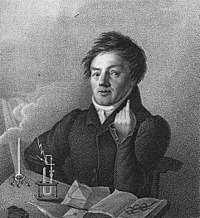Johann Wolfgang Döbereiner
Johann Wolfgang Döbereiner | |
|---|---|
 Johann Wolfgang Döbereiner | |
| Born | 13 December 1780 |
| Died | 24 March 1849 (aged 68) |
| Nationality | German |
| Known for | Döbereiner's triads Döbereiner's lamp |
| Family | he had one wife and fore kids and dad that died when he was younge |
| Scientific career | |
| Fields | Chemistry |
Johann Wolfgang Döbereiner (13 December 1780 – 24 March 1849) was a German chemist who is best known for work that foreshadowed the periodic law for the chemical elements.
Life and work
As a coachman's son, Döbereiner had little opportunity for formal schooling. So he was apprenticed to an apothecary, reading widely and attending science lectures. He eventually became a professor at the University of Jena in 1810; he also studied chemistry at Strasbourg. In work beginning in 1829,[1] Döbereiner discovered trends in certain properties of selected groups of elements. For example, the average atomic mass of lithium and potassium was close to the atomic mass of sodium. he also had one wife and fore kids and a dad that died when Johnann was very little so he only had his mum A similar pattern was found with calcium, strontium, and barium, with sulphur, selenium, and tellurium, and also with chlorine, bromine, and iodine. Moreover, the densities for some of these triads followed a similar pattern. These sets of elements became known as "Döbereiner's triads".[1][2]

Döbereiner also is known for his discovery of furfural,[3] for his work on the use of platinum as a catalyst, and for a lighter, known as Döbereiner's lamp.
The German writer Goethe was a friend of Döbereiner, attended his lectures weekly, and used his theories of chemical affinities as a basis for his famous 1809 novella Elective Affinities
Works
- Deutsches Apothekerbuch . Vol. 1-3 . Balz, Stuttgart 1842-1848 Digital edition by the University and State Library Düsseldorf
References
- ^ a b "Johann Wolfgang Dobereiner". Retrieved 2008-03-08.
- ^ "A Historic Overview: Mendeleev and the Periodic Table" (PDF). Retrieved 2008-03-08.
- ^ J. W. Döbereiner (1832). "Ueber die medicinische und chemische Anwendung und die vortheilhafte Darstellung der Ameisensäure". Berichte der deutschen chemischen Gesellschaft. 3 (2): 141–146. doi:10.1002/jlac.18320030206.
Further reading
- Collins, P. M. D. (1986). "The Pivotal Role of Platinum in the Discovery of Catalysis" (PDF). Platinum Metals Review. 30 (3): 141–146.
- Döbereiner, Johann Wolfgang (1829). "An Attempt to Group Elementary Substances according to Their Analogies". Annalen der Physik und Chemie. 15: 301–307.
- Hoffmann, Roald (Jul–Aug 1998). "Döbereiner's Lighter". American Scientist. 86 (4): 326. doi:10.1511/1998.4.326.
- Hoffmann, Roald (1998). "Döbereiner's Lighter". American Scientist. 86 (4): 326. doi:10.1511/1998.4.326. Archived from the original on March 24, 2006.
{{cite journal}}: Unknown parameter|deadurl=ignored (|url-status=suggested) (help) - Kauffman, George B. (1999). "Johann Wolfgang Döbereiner's Feuerzeug". Platinum Metals Review. 43 (3).
- Kaufmann, George (1999). "From Triads to Catalysis: Johann Wolfgang Döbereiner (1780–1849) on the 150th Anniversary of His Death". The Chemical Educator. 4 (5): 186–197. doi:10.1007/s00897990326a.
- McDonald, Donald (1965). "Johann Wolfgang Döbereiner" (PDF). Platinum Metals Review. 9 (4): 136–139.
- Prandtl, Wilhelm (1950). "Johann Wolfgang Dobereiner, Goethe's Chemical Adviser". Journal of Chemical Education. 27 (4): 176–181. Bibcode:1950JChEd..27..176P. doi:10.1021/ed027p176.
- Kimberley A. McGrath, Bridget Travers. 1999. World of Scientific Discovery. Gale Research.
